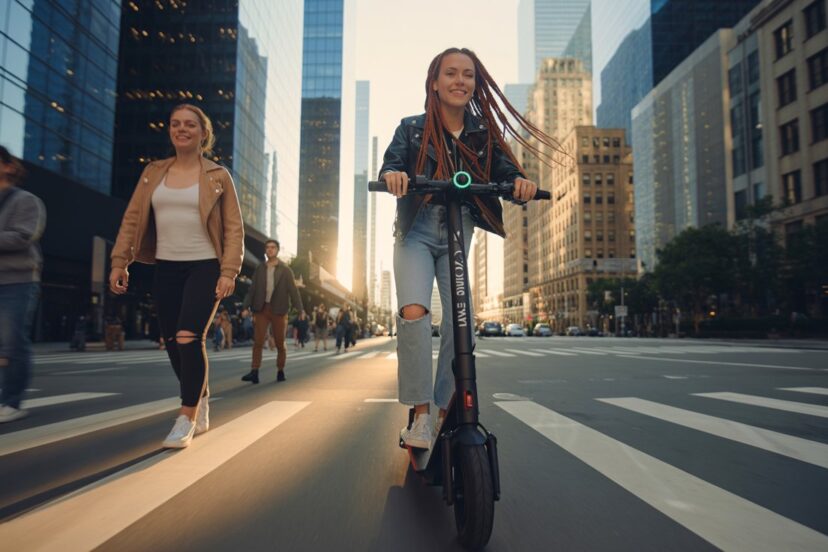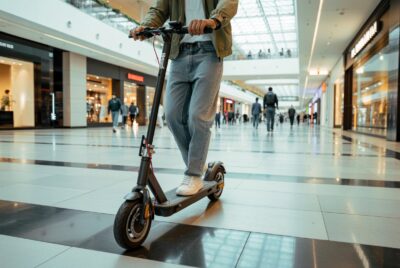E-Scooters in Car-Centric Cities: Solution or Problem?
*We may earn a commission for purchases made using our links. Please see our disclosure to learn more.
The morning rush hour paints a familiar picture in cities worldwide: endless streams of single-occupancy vehicles crawling through congested streets, their engines idling as frustrated drivers inch toward their destinations. Into this automotive maze has emerged an unlikely challenger—the electric scooter, a device that weighs less than 30 pounds yet promises to revolutionize how people navigate urban landscapes.
The emergence of e-scooters in car-dominated cities has sparked intense debate among urban planners, policymakers, and residents alike. Are these nimble devices the transportation solution cities desperately need, or do they represent yet another challenge in already complex urban environments? The answer, as with most urban mobility questions, lies somewhere between these extremes.
“The rise of e-scooters represents one of the most significant shifts in urban mobility since the advent of ride-sharing services. They offer a glimpse into a future where cities prioritize people over cars.”
— Urban Transportation Research Institute
Key Takeaways
The integration of e-scooters into car-centric cities represents both an opportunity and a challenge for urban mobility. Success depends on thoughtful implementation that addresses legitimate concerns while maximizing transportation benefits.
- Transportation Integration: E-scooters work best as part of comprehensive transportation systems rather than standalone solutions. Their effectiveness increases when integrated with public transit, cycling infrastructure, and pedestrian networks.
- Regulatory Foundation: Proactive, performance-based regulation that balances innovation with public safety and accessibility creates better outcomes than reactive bans or unrestricted deployment.
- Infrastructure Investment: Cities that invest in appropriate infrastructure—including protected bike lanes, designated parking areas, and clear signage—see higher adoption rates and fewer conflicts.
- Equity Considerations: Successful programs actively address equity concerns through service area requirements, alternative payment options, and community engagement in underserved areas.
- Data-Driven Decision Making: Regular evaluation using comprehensive data about usage patterns, safety outcomes, and environmental impacts enables continuous improvement in program management.
- Stakeholder Engagement: Including diverse voices—disability advocates, business owners, residents, and transportation companies—in planning processes leads to more successful implementations.
The Urban Mobility Crisis
Car-centric cities face mounting challenges that traditional transportation infrastructure struggles to address. Traffic congestion costs the average American driver over 50 hours annually in lost time, while air quality deteriorates under the weight of vehicular emissions. Parking demands consume valuable urban real estate, and the financial burden of car ownership—averaging over $9,000 annually per vehicle—excludes many residents from reliable transportation options.
These challenges create what transportation experts call the “last-mile problem.” Even in cities with robust public transportation networks, the gap between transit stations and final destinations often forces residents back into private vehicles for short trips that could theoretically be completed by other means.
Urban planners have long recognized that dedicating 30-60% of city space to automobiles and their storage creates unsustainable patterns of development. Yet breaking free from car-centric design proves remarkably difficult when existing infrastructure, zoning laws, and cultural expectations all favor automotive transportation.
The E-Scooter Revolution
Electric scooters entered this complex landscape with remarkable speed. From zero devices in 2017 to over 136 million trips taken globally by 2019, e-scooters demonstrated unprecedented adoption rates for a new transportation mode. Their appeal lies in addressing specific urban mobility gaps that traditional solutions struggle to fill.
The devices excel at bridging the last-mile gap, turning a 15-minute walk into a 4-minute ride. For distances between one and three miles—too far to walk comfortably but too short to justify driving—e-scooters offer an appealing middle ground. Their electric motors eliminate the physical exertion required for cycling, making them accessible to users who might otherwise rely on cars for short trips.
Deployment flexibility represents another significant advantage. Unlike bike-sharing systems that require expensive docking stations, e-scooters can be distributed throughout urban areas and relocated based on demand patterns. This adaptability allows transportation companies to respond quickly to changing user needs and seasonal variations in ridership.
The environmental appeal of e-scooters resonates with environmentally conscious urban residents. When used to replace car trips, e-scooters can significantly reduce per-mile carbon emissions, despite the environmental costs associated with their manufacturing and relatively short lifespan.
Challenges and Urban Friction
The rapid deployment of e-scooters revealed significant challenges that tempered initial enthusiasm. Sidewalk clutter became an immediate concern as improperly parked devices blocked pedestrian access and created obstacles for individuals with mobility devices. Cities unprepared for sudden influxes of shared mobility devices struggled to develop appropriate regulatory frameworks.
Safety concerns emerged as e-scooter-related injuries increased alongside adoption rates. Emergency room visits attributed to e-scooter accidents rose sharply in cities with large fleets, though researchers debate whether these incidents represent inherent device dangers or the natural consequences of integrating any new transportation mode into complex urban systems.
The economics of e-scooter operations proved more challenging than initial projections suggested. High rates of vandalism, theft, and weather-related damage, combined with the costs of redistribution and maintenance, created sustainability questions for many operators. Several major companies exited markets or significantly reduced operations after struggling to achieve profitability.
Equity concerns also surfaced as critics noted that e-scooter services primarily served affluent neighborhoods and demographics. The requirement for smartphones and credit cards for access, combined with deployment patterns favoring high-income areas, raised questions about whether these devices truly democratized urban mobility or simply provided another amenity for privileged populations.
Integration Success Stories
Despite these challenges, several cities have successfully integrated e-scooters into their transportation ecosystems through thoughtful planning and regulation. These success stories offer valuable lessons for other urban areas considering how to incorporate micromobility options.
Effective integration typically begins with comprehensive regulatory frameworks developed through stakeholder engagement. Cities that brought together transportation companies, disability rights advocates, business owners, and residents before large-scale deployments often achieved smoother implementation processes than those that adopted reactive approaches.
Infrastructure adaptation plays a crucial role in successful e-scooter integration. Cities that invested in protected bike lanes, designated parking areas, and clear signage created environments where e-scooters could operate safely without conflicting with pedestrian traffic or automotive systems.
Data sharing agreements between cities and operators have enabled evidence-based policy making. When transportation companies provide anonymized usage data, city planners can identify high-demand areas, optimize parking locations, and understand how e-scooters complement existing transportation options.
Successful programs often emphasize education and community engagement. Cities that invested in public awareness campaigns about safe riding practices, parking etiquette, and integration with other transportation modes saw higher compliance rates and greater public acceptance.
The Broader Transportation Ecosystem
Understanding e-scooters’ role requires examining how they fit within comprehensive urban transportation systems. Rather than competing directly with cars, successful e-scooter programs complement existing transportation options by filling specific gaps in the mobility network.
Integration with public transit represents one of the most promising applications. E-scooters can extend the effective reach of bus and rail systems by providing convenient connections between stations and final destinations. This integration can increase public transit ridership while reducing pressure on parking infrastructure around transit hubs.
The relationship between e-scooters and cycling infrastructure demonstrates how different transportation modes can share resources efficiently. Cities with extensive bike lane networks often see higher e-scooter adoption rates and fewer conflicts between devices and pedestrian traffic.
Seasonal and weather-related usage patterns reveal how e-scooters function as part of multimodal transportation strategies. Users often combine e-scooters with other transportation options based on distance, weather conditions, and trip purposes, suggesting that successful urban mobility systems require diverse options rather than single solutions.
Economic and Environmental Implications
The economic impact of e-scooters extends beyond direct operational costs and revenues. When e-scooters replace car trips, they can reduce demand for parking infrastructure, potentially freeing valuable urban real estate for other uses. The economic value of reduced traffic congestion, though difficult to quantify precisely, represents a significant potential benefit for cities struggling with automotive gridlock.
Local business impacts vary considerably based on implementation and usage patterns. Some retail areas report increased foot traffic as e-scooters make it easier for customers to reach businesses, while others express concern about sidewalk clutter and parking conflicts.
Environmental assessments of e-scooters reveal complex tradeoffs. While the devices produce zero direct emissions during operation, their lifecycle environmental impact includes manufacturing, transportation, redistribution, and disposal considerations. Studies suggest that environmental benefits depend heavily on what transportation modes e-scooters replace—substituting for car trips provides clear environmental advantages, while replacing walking or cycling may increase overall environmental impact.
The carbon footprint of e-scooter operations varies significantly based on fleet management practices. Companies that use electric vehicles for redistribution and invest in device durability can substantially reduce the environmental impact per trip compared to those relying on conventional vehicles and shorter-lived devices.
Policy and Regulatory Frameworks
Effective e-scooter regulation requires balancing innovation with public safety and urban livability. Cities worldwide have experimented with different regulatory approaches, providing valuable lessons about policy frameworks that support successful integration.
Permit systems that limit fleet sizes and require performance standards have proven more effective than either complete bans or unrestricted deployment. Cities that established clear criteria for operator permits—including safety requirements, data sharing obligations, and equity provisions—generally achieved better outcomes than those with ad hoc approaches.
Parking and placement regulations represent critical components of successful policy frameworks. Cities that designated specific parking areas, prohibited certain placement locations, and established clear penalties for non-compliance saw significant improvements in sidewalk accessibility and public acceptance.
Performance-based regulation, where operators must meet ridership, safety, and equity metrics to maintain permits, encourages responsible business practices while allowing market competition to drive innovation. This approach has proven more effective than purely prescriptive regulations that may not adapt well to evolving technology and usage patterns.
Revenue sharing and fee structures that require operators to contribute to transportation infrastructure or equity programs can help cities capture some of the value created by public right-of-way use while funding broader transportation improvements.
Future Perspectives and Emerging Trends
The evolution of e-scooter technology continues to address many early concerns about safety, durability, and user experience. Improved battery technology extends range and reduces charging frequency, while better materials and design increase device lifespan and reduce maintenance requirements.
Integration with smart city infrastructure promises to enhance e-scooter functionality and management. Real-time data about traffic conditions, weather, and demand patterns can optimize fleet distribution and routing, while integration with traffic management systems could prioritize e-scooter movements through intersections during peak usage periods.
The expansion of e-scooter services to suburban and smaller urban areas represents a significant growth opportunity. As technology improves and operational costs decrease, these devices may become viable transportation options in lower-density areas previously considered unsuitable for shared mobility services.
Autonomous e-scooters, currently in development by several companies, could address many operational challenges related to redistribution and maintenance while reducing long-term costs. However, this technology also raises new questions about urban space usage and regulatory oversight.
Conclusion
E-scooters neither represent a panacea for urban transportation challenges nor constitute an inherent threat to city livability. Instead, they offer one tool among many that cities can use to create more sustainable, accessible, and efficient transportation systems.
The key to successful integration lies in recognizing that transportation systems must evolve to meet changing urban needs while maintaining safety, accessibility, and livability standards. Cities that approach e-scooter integration thoughtfully—with comprehensive planning, appropriate regulation, and genuine commitment to equity—can realize significant benefits for their residents and transportation networks.
As urban areas continue to grow and environmental concerns intensify, the pressure to find alternatives to car-centric transportation will only increase. E-scooters, properly implemented, can play a valuable role in creating transportation systems that serve all residents while supporting broader goals of sustainability and livability.
The future of urban mobility likely includes e-scooters alongside traditional transportation modes, each serving specific needs within integrated systems designed to move people efficiently while preserving the qualities that make cities attractive places to live and work.
Frequently Asked Questions
Q: Are e-scooters safe to use in traffic-heavy urban environments?
A: E-scooter safety depends largely on infrastructure and user behavior. Cities with protected bike lanes and clear traffic rules for e-scooters generally see lower accident rates. Users can improve safety by wearing helmets, following traffic laws, and avoiding riding on sidewalks or in heavy traffic when bike lanes aren’t available.
Q: How do e-scooters impact the environment compared to cars?
A: When e-scooters replace car trips, they typically reduce carbon emissions by 30-65% per mile. However, their environmental benefit depends on what transportation mode they replace—substituting for walking or cycling may actually increase environmental impact due to manufacturing and redistribution emissions.
Q: What happens to e-scooters during winter or bad weather?
A: Most e-scooter operators reduce or suspend service during severe weather conditions. In cities with harsh winters, fleets are often removed entirely during winter months. Some newer models feature improved weather resistance, but safety concerns generally limit operation during rain, snow, or ice conditions.
Q: How much do e-scooters cost compared to other transportation options?
A: E-scooter costs vary by city and provider, typically ranging from $1-3 to start plus $0.15-0.50 per minute. For trips under two miles, they’re often cost-competitive with ride-sharing services but more expensive than public transit. However, they may save money compared to car ownership when considering parking, insurance, and maintenance costs.
Q: Can people with disabilities use e-scooter services?
A: Standard e-scooters aren’t accessible to many people with mobility disabilities. However, some companies are developing adaptive devices, and cities are requiring operators to provide alternative accessible options. The bigger accessibility concern involves ensuring that parked e-scooters don’t block sidewalks or curb cuts needed by wheelchair users and people with visual impairments.




